As The Commonwealth enters a new era…

At the beginning of September the world’s longest reigning monarch, Queen Elizabeth II of Great Britain and Northern Ireland passed away. Throughout her reign she was head of the Commonwealth of Nations (usually referred to as the Commonwealth). For seven decades Queen Elizabeth II provided support and consistency to all the commonwealth members.
Predictive factors for successful limb salvage surgery among patients with diabetic foot in Capitol Medical Center, Philippines

The role of limb salvage is to restore and maintain stability and ambulation. Some surgeons, who are advocates of limb salvage procedures, often delay amputation, leading to worsening of patients’ clinical condition and to multiple operative procedures, eventually resulting in a major limb amputation. Other clinicians do an outright major limb amputation even in mild […]
Improved Bates-Jensen score following negative pressure wound therapy on wounds of various aetiologies: an experience from a tertiary care centre
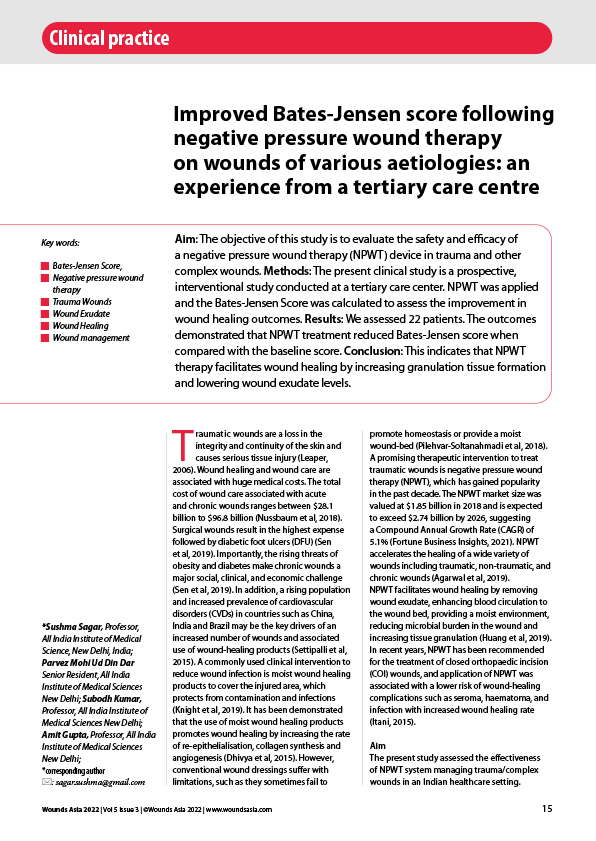
Aim: The objective of this study is to evaluate the safety and efficacy of a negative pressure wound therapy (NPWT) device in trauma and other complex wounds. Methods: The present clinical study is a prospective, interventional study conducted at a tertiary care center. NPWT was applied and the Bates-Jensen Score was calculated to assess the […]
Product showcase: 3M™ Veraflo™ Therapy
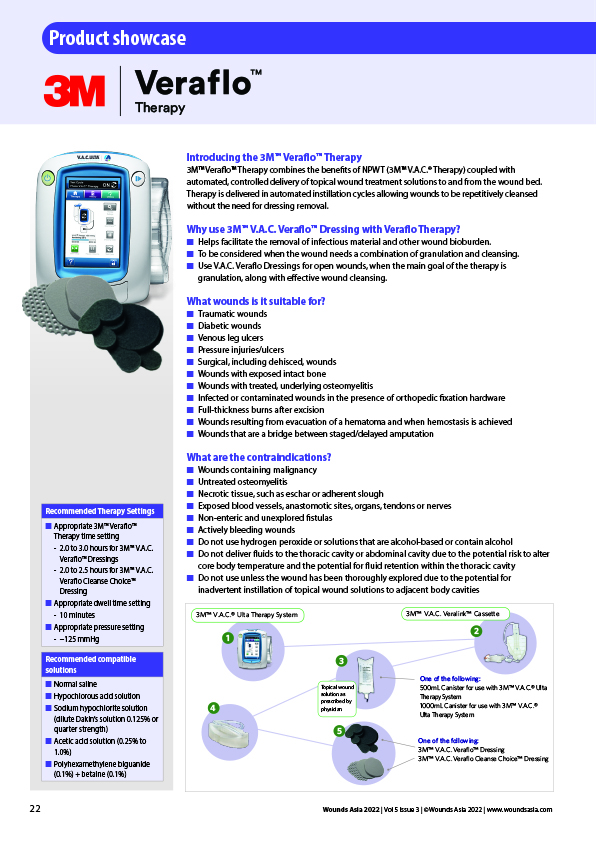
Introducing the 3M™ Veraflo™ Therapy 3M™ Veraflo™ Therapy combines the benefits of NPWT (3M™ V.A.C.® Therapy) coupled with automated, controlled delivery of topical wound treatment solutions to and from the wound bed. Therapy is delivered in automated instillation cycles allowing wounds to be repetitively cleansed without the need for dressing removal.
Assessing skin tones in practice: Results of an international survey

Following the publication of the Wounds UK Best Practice Statement ‘Addressing skin tone bias in wound care: assessing signs and symptoms in people with dark skin tones’ (Dhoonmoon et al, 2021), we conducted an international survey of healthcare professionals to learn more about everyday practice, how skin tones are assessed and where more education is […]
Novel wound debridement using organic acid to desiccate biofilm: a prospective case series in Kuala Lumpur

Chronic wounds impact heavily on the patient’s quality of life, as well as on the national economy. Biofilm found in chronic wounds can inhibit healing, this makes debridement necessary to disrupt and remove the biolfim to restart the healing process. A topical dehydrating agent A (TDA A) has been developed as a new form of […]
Use of collagenase and hyaluronic acid ointment in treating chronic wounds: a case series

This case series investigates the recovery of chronic wounds treated with hyaluronic acid-collagenase (Hyalo4® Start), which facilitates enzymatic debridement, helping prepare the wound bed for healing and closure on top of first-line therapy. We recruited 15 patients with different underlying comorbidities who consented to participate in the case study. Selection criteria include patients with chronic […]
Clinical effect of subcutaneous application of Cellmax® on treating chronic wounds: a case series

Chronic wounds include, but are not limited to diabetic foot ulcers (DFU), venous leg ulcers (VLU), and pressure ulcers (PU) that do not progress through the healing process in a timely manner. This case series aims to investigate the recovery of chronic wounds treated with Cellmax®, which contains secretory factors, bioactives and bioproteins from mesenchymal […]
Evaluation of a novel chitosan wound healing dressing based on bioactive microfibre gelling (bmg) technology™: A case series

Health professionals can be overwhelmed by the number of wound dressings currently available. Their choice is based on clinical evidence and also on their clinical expertise and experiences. Chitosan is a natural cationic polysaccharide that is the partially- to fully-deacetylated form of chitin. There is great interest in the use, as this biopolymer is the […]
Wondaleaf Adhesive Pouch (WLAP) and Wondaleaf Flat Dressing in the treatment of wounds in patients with diabetes: a single-centre study

Diabetic wounds pose a significant social and economic burden to healthcare systems globally. Film dressings have been known to aid the healing of diabetic foot ulcers by creating a clean, moist wound environment. This study aims to investigate the efficacy of Wondaleaf Adehesive Pouch (WLAP) and Wondaleaf Flat Dressing in wounds in patients with diabetes. […]
International Consensus Document: Diabetic foot ulcer care in the Asia-Pacific region

The global prevalence of diabetes and diabetic foot ulcers (DFUs) is increasing, with growing threat of morbidity, amputation and mortality. In the Asia-Pacific (APAC) region, this issue is particularly urgent. The International Diabetes Federation (IDF) estimates that there were 537 million people living with diabetes globally in 2021, and that this number will increase to […]
Perforating osteoma cutis: a case study
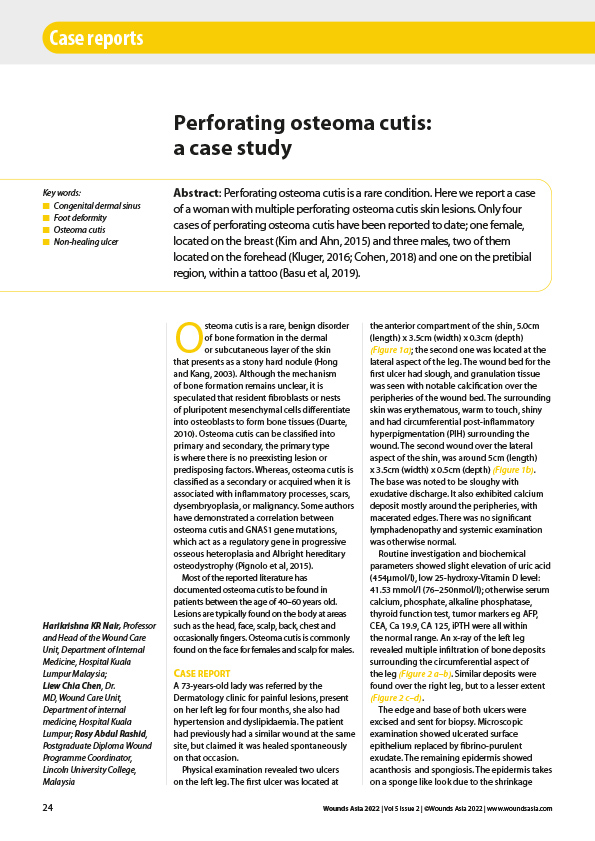
Perforating osteoma cutis is a rare condition. Here we report a case of a woman with multiple perforating osteoma cutis skin lesions. Only four cases of perforating osteoma cutis have been reported to date; one female, located on the breast (Kim and Ahn, 2015) and three males, two of them located on the forehead (Kluger, […]
Treatment of recalcitrant seroma with a novel hybrid tube-drain system: Review of the postoperative seroma management and case reports

Current literature presents four techniques of management of seroma — open NPWT, bedside aspiration and/or drain insertion, surgical capsulectomy and chemical sclerotherapy. We present two cases of access related seromas: one, a case of recalcitrant seroma post-autologous arteriovenous dialysis access creation, and another patient who developed a perigraft seroma adjacent to the venous anastomosis. The […]
Powering the progression of hard-to-heal wounds with electrical stimulation: observational analysis of wounds treated with Accel-Heal
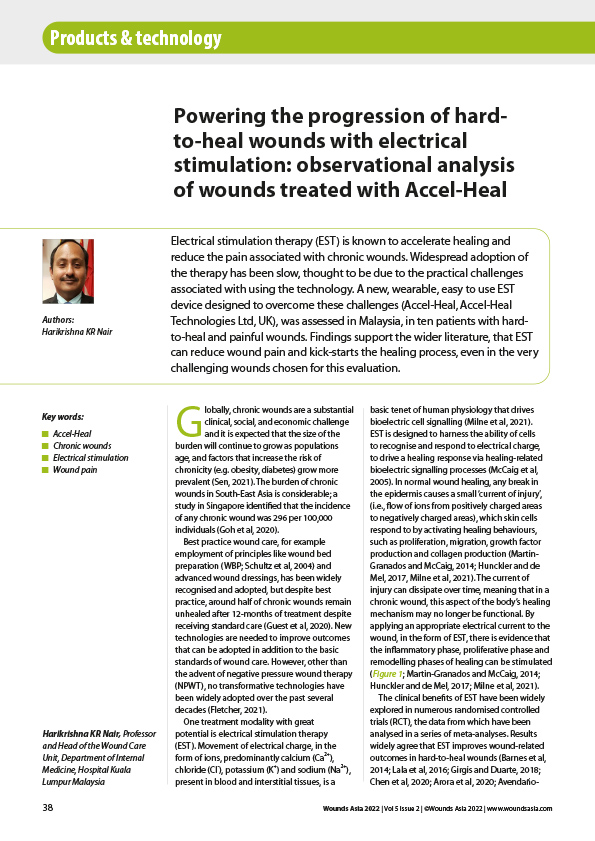
Electrical stimulation therapy (EST) is known to accelerate healing and reduce the pain associated with chronic wounds. Widespread adoption of the therapy has been slow, thought to be due to the practical challenges associated with using the technology. A new, wearable, easy to use EST device designed to overcome these challenges (Accel-Heal, Accel-Heal Technologies Ltd, […]
The effectiveness of Wondaleaf flat dressing and adhesive pouch dressing as a secondary dressing

Aim: To investigate the effectiveness of Wondaleaf dressing on healing speed and reduction of wound size. Methods: The clinical benefits of using Wondaleaf flat dressing and Wondaleaf Adhesive Pouch Dressing (WLAP) in the management of patients with a variety of wounds. Patients with venous leg ulcers, carbuncles, chronic ulcer following a trauma injury, abscess, pressure ulcers […]
Wounds digest

In this section, a brief synopsis is presented of a range of recently published articles that may be of interest to healthcare professionals working in the wound care setting. The aim of this round-up is to provide an overview, rather than a detailed summary and critique, of the research papers selected. Full references are provided […]
Evidence versus experience: the wound care dilemma

Dear friends and family, it feels like life is returning to a form of normality, as we move away from the global COVID-19 pandemic and begin to live with this coronavirus (SARS-CoV-2) as we have done with other coronavirus and indeed other viruses. Many wound care centres are back to their full strength, this is […]
The use of an imaging application in chronic wound management among nursing home patients: a pilot study

Aim: Our study explores the use of CARES4WOUNDS (C4W) application to manage chronic wounds in nursing homes over a two-month period. Methods: The intervention group was managed using C4W while the control group was managed by wound care nurses. Results: We recruited 9 patients to the pilot study, however, two were excluded after being transferred to hospital […]
Reintroduction of maggot debridement therapy in the treatment of diabetic foot ulcers in Singapore: a single institution’s initial experience

Background: Diabetes mellitus is often associated with peripheral vascular disease and limb ulcers. Among diabetics, the lifetime risk of developing a foot ulcer is approximately 15%. Maggot debridement therapy (MDT) uses sterile, medical-grade maggots for non-surgical treatment of necrotic or sloughy wounds. Aim: This study aims to ascertain the safety and efficacy of MDT using locally […]
Perforating osteoma cutis: a case study

Perforating osteoma cutis is a rare condition. Here we report a case of a woman with multiple perforating osteoma cutis skin lesions. Only four cases of perforating osteoma cutis have been reported to date; one female, located on the breast (Kim and Ahn, 2015) and three males, two of them located on the forehead (Kluger, […]
Data driven evidence-based wound care in developing countries: challenges, requirements and significance

Wounds are a serious public health issue and despite the large prevalence, crucial information such as prevalence rate, wound types, and treatment approaches are not properly documented. The lack of crucial wound care data significantly hampers the development of innovative technological solutions and formulation of effective healthcare policies. Some of the reasons for the lack […]
The influence of electrical muscle stimulation for diabetic foot ulcers
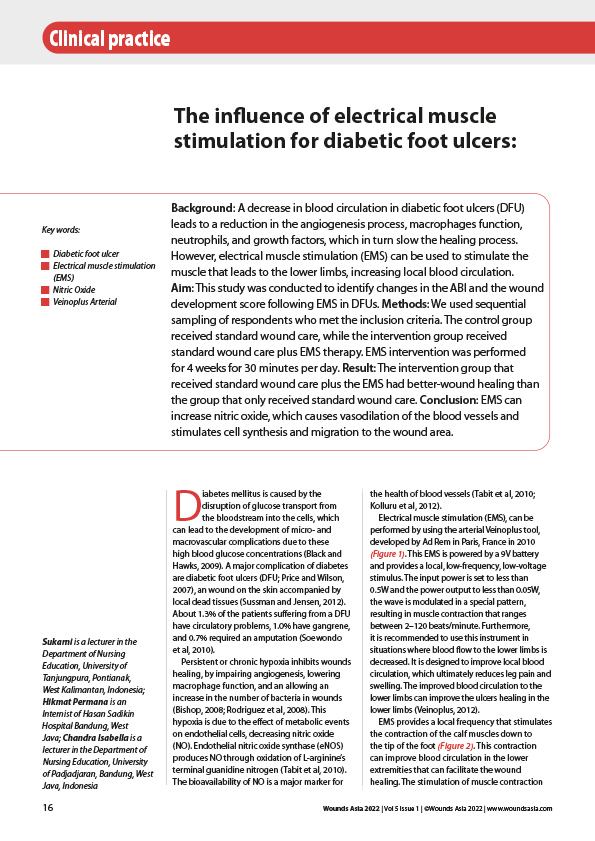
Background: A decrease in blood circulation in diabetic foot ulcers (DFU) leads to a reduction in the angiogenesis process, macrophages function, neutrophils, and growth factors, which in turn slow the healing process. However, electrical muscle stimulation (EMS) can be used to stimulate the muscle that leads to the lower limbs, increasing local blood circulation. Aim: […]
Antibiofilm coated implants in the prevention and treatment periprosthetic infection: a case series

For many years infection has been the leading cause of implant failure and different approaches have been used to overcome the difficulties faced with infection management. Commonly, implant infection occurs due to biofilm formation, and a better understanding of this has led to the prevention of biofilm formation. The coating of implants with antibiotics and […]
World Union of Wound Healing Societies 2022: success in Abu Dhabi and Kuala Lumpur hosts 2026

When planning an event such as the World Union of Wound Healing Societies (WUWHS), it is imperative to gain the help of experts in the field. Their willingness to share their time and expertise in wound care was critical to the success of this event. Thanks to your sponsorship, support and participation, we put on […]
Efficacy of topical mupirocin versus 2% mupirocin in novel Cogen-S base in chronic skin ulcers: a pilot study
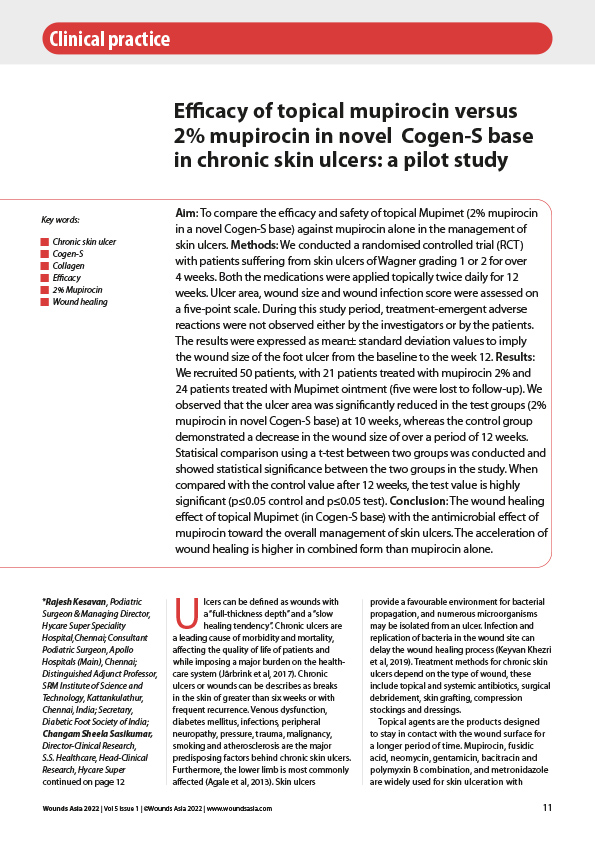
Aim: To compare the efficacy and safety of topical Mupimet (2% mupirocin in a novel Cogen-S base) against mupirocin alone in the management of skin ulcers. Methods: We conducted a randomised controlled trial (RCT) with patients suffering from skin ulcers of Wagner grading 1 or 2 for over 4 weeks. Both the medications were applied […]
Spina Bifida with foot deformity and a chronic non-healing ulcer in a 12-year-old boy: a case study

Congenital dermal sinuses are a distinctive form of occult dysraphism where patients present with neurological compression, tethering, or meningitis. This is a case study of a child presenting with spina bifida with foot deformity and a chronic non-healing ulcer after excision of dermal sinus, and subsequent tethered cord due to arachnoiditis. He developed osteomyelitis and […]
Assessment of adherent silicone foam dressing with technology lipidocolloid: a case series from China

Wound healing is a complex process that may be affected by various factors. An appropriate microenvironment is necessary to attain accelerated healing. Modern dressings are designed to facilitate healing by providing the moist wound environment needed, but also to provide an atraumatic experience for the patients. This article discusses three cases where a silicone border […]
Mupirocin ointment in the treatment of chronic non-healing wounds: a case series

Mupirocin ointment (Supirocin ointment) is a topical antimicrobial that contains an active substance called mupirocin. It is used in adults, adolescents, children and infants aged ≥4 weeks to treat infections on the skin such as infected hair follicles that form pimples containing pus (folliculitis), skin infection with blistering and crusting (impetigo) or recurring boils (furunculosis). […]
Use of an advanced extracellular matrix dressing in the treatment of acute and chronic wounds: a Malaysian case series

Chronic wounds are becoming an increasing burden on healthcare systems as the Malaysian population develops more complex comorbidities. These wounds present a challenge for health professionals to treat without having access to advanced wound healing technologies that have not been available in Malaysia. We report a retrospective case series (n=10) detailing one Malaysian wound care […]
International Stop Wound Infection Day (SWID)

The International Wound Infection Institute (IWII), have launched the first international Stop Wound Infection Day (SWID) by showcasing your research, technologies and initiatives on social media. #stopwoundinfectionday find out more here: www.woundinfectionawareness.com We hope that you will join and support our annual Stop Wound Infection Day, starting with Thursday 21st October 2021. We want […]
Treatment of chronic wounds with healus wound gel: a case series

Advanced wound dressings have evolved to do more than just providing moist wound environment for better wound healing. Here we measure the wound healing efficacy of a new hydrogel as shown by the reduction in wound area reduction. This case series includes ten patients with chronic wounds of different aetiologies, diabetes foot ulcers (DFU), infected […]
Treatment of chronic wounds with a single-use negative pressure wound therapy system: a case series

Negative pressure wound therapy (NPWT), is a wound dressing system that continuously or intermittently applies subatmospheric pressure to the surface of the wound, and provides a positive pressure to the surface of the wound to aid healing. The aim of this study was to assess the healing of chronic wounds treated by single-use NPWT. Study […]
When will we meet again: publications and live conference

Dear readers from the Asian wound family, and beyond, it’s a pleasure to showcase another edition of the Wounds Asia journal, amid the COVID-19 pandemic, which is ravaging the economies and health budgets globally.
The growing costs and consequences of diabetic foot ulcers

Diabetic foot ulcers (DFU) are one of the most feared complications in diabetes. Neuropathy and ischaemia are two common pathologies of the foot in pateints with diabetes, which can lead to the typical features of foot ulceration and Charcot neuroarthropathy. Secondary infection can eventually result in amputation (minor or major) and increased mortality. All of […]
Surviving the pandemic and creating new norms: our pandemic story

It was at the end of 2019 when we first heard about the SARS-CoV-2 or COVID-19 virus in the news, but we were not worried. Then, we thought of COVID-19 as an ordinary flu virus, which we experience from time-to-time, with the usual cough and colds. Thinking that it will never reach us we are […]
Self-care foot assessment and e-Health services for diabetic foot ulcer patients: a mobile phone app

Foot complications from diabetes mellitus are one of main causes of lower limb amputation, however, public awareness of diabetic foot care is low. A mobile app “Happy Feet” was developed,s targeting patients with diabetic foot ulcers (DFU). Patients foot awareness substantially increased after three and six months of using the application. Mean total scores between […]
Collar button abscess of the foot: a case report

The upper and lower limbs are the most exposed parts of the body, predisposing these areas for minor or major trauma, which can result in loss of skin integrity and bacterial inoculation. Seemingly minor injury, when not given early attention, may result in bacterial overgrowth and lead to deep space infections, especially in immunocompromised individuals. […]
Periwound skin management of chronic lower-limb wounds with use of a novel multi-ingredient skin cleanser: a single-centre study

The condition and moistness of periwound skin has been directly linked to the success of wound bed preparation and wound healing. This study investigates the use of a novel skin cleanser designed to enhance periwound recovery, in a population of 61 patients seeking outpatient care at the wound clinic of Kuala Lumpur General Hospital for […]
Wound management with Technology Lipido-Colloid Silver Non-Adherent dressing: a case series from Chinese clinicians

Prevention and appropriate management of wound infection is central to promote the healing process. While not all wounds will necessitate use of systemic antibiotics, some may benefit from the use of topical antimicrobials as part of a holistic standard of care. This article describes five different cases, from China, where the clinicians used Technology Lipido-Colloid […]
A novel approach to chronic wound management using a patented cream of silicon dioxide, silver ions, chlorhexidine and hyaluronic acid

Chronic wounds with low healing rate generally lead to decreased in quality of life of patients, financial burden and increased morbidity rate (Järbrink et al, 2016). Thus, wound care management involving a patented 4-in-1 formulation is an aid in the management of chronic wounds. To demonstrate its efficacy, seven patients were chosen, four with a […]
Effects of photobiomodulation with blue light on diabetic foot ulcers: a case series report

Due to the poor circulatory system, a wound in a person with diabetes can demonstrate a persistent and protracted inflammatory response that results in reduced cellular proliferation and production of growth factors. Photobiomodulation (PBM), also known as low-level light therapy, is an application of light to promote beneficial effects such as reduction of inflammation and […]
UrgoClean Ag in Real Life

In 2019, the International Diabetes Federation (IDF) reported that over 77 million individuals have diabetes in India, which will increase to over 100 million by 2030 (IDF, 2019). Of these people with diabetes, 25% will develop a diabetic foot ulcer (DFU), equating to 5 million by 2030. Overall, half of ulcers become infected during the […]
Post-surgical incision care across the Asia-Pacific region: current practice and perceptions

Background and Aims: Post-surgical incision care is a critical component in optimising patient outcomes and has the potential to reduce the risk of infection and associated complications. Dressing characteristics, selection and change frequency are important aspects of achieving good outcomes. The aims of this study were to gain insights into the current practice of post-surgical […]
Hip disarticulation wound treated with antibacterial medical honey: a case report

Hip disarticulation accounts for approximately 0.5% of the lower limb amputation. Wound management post-hip disarticulation is an arduous task. Honey has antioxidant, antibacterial and antiinflammatory properties. Antibacterial medical honey (Medihoney) usage is proven in wound care especially its role against antibioticresistant bacteria such as methicillin-resistant Staphylococcus aureus (MRSA). Antibacterial medical honey in surgical wounds promotes […]
Effectiveness of multipurpose liquid polyurethane foamed bandage (LOKUS) in wound area reduction

Polyurethane foam dressings have shown potential in the treatment of acute and chronic wounds due to their unique biomechanical properties. The LOKUS polyurethane foam is a liquid foam dressing previously shown in a small single-centre study to demonstrate high absorptive capability and reliable adhesion to the wound surface. This case series describes the usage of […]
Clinical evaluation of UrgoClean Ag (poly-absorbent dressing based on technology lipido-colloid with silver ions) in the management of infected wounds in Asia

Wound infections, including biofilms play a significant role in delaying wound healing and are considered to be one of the major challenges in wound management. The presence of non-viable tissue, such as slough, is a prominent feature of chronic wounds and is considered as a barrier against successful wound healing. A key component in wound […]
Self-administration of Garcinia mangostana standardise pericarp extract to aid wound healing in diabetic and non-diabetic patients

In this era of civilisation, modern societies are beginning to reconsider holistic remedies used millennia ago in spite of various technologic and strategic advances. Several studies have shown that the standardised extract of DermaXan (Mangosteen; Garcinia mangostana) pericarp has antibacterial effect, high antioxidant and anti-inflammatory effect. The aim of this on-going study is to assess […]
Effects of immunonutrition in patients with chronic wounds: a case series

Chronic wounds have been well known to negatively impact on a patients quality of life (QoL). Chronic wounds and illnesses such as diabetes mellitus are chronic inflammatory states and are associated with increased energy expenditure and catabolism of lean body mass. This causes a decline in nutritional status, which in turn prevents wound healing. Studies […]
#Education #Education #Education

Salutations and wishes of good health to all our esteemed readers from the wound family. I truly hope everyone is staying safe with the necessary safety precautions during this “new normal”. Many exciting things are going on in the world beside the COVID-19 pandemic ravaging through the free world as we know it.
Malaysia bids for the 7th World Union of Wound Healing Societies (WUWHS) conference 2026

The World Union of Wound Healing Societies (WUWHS) conference is held every four years once and is noted to be the “Wound Olympics” with more than 6000 delegates from a hundred over countries. It began in Melbourne, Australia in the year 2000 and has been conducted in Paris, Toronto, Yokohama and Florence. The 6th WUWHS […]



